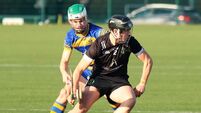Small steps that lead to giant leaps

On rooting in my storage space (ie my side of the bed), I discovered I no longer owned a pair of football boots, and realised I’d bought my last pair of boots without knowing it, a watershed of some importance.
A couple of weekends ago, I hit a related watershed when I bought a very first pair of football boots for a small person in this house.
My own first pair of football boots were bought so long ago I’d be lying if I said I could remember much detail, but I am confident it didn’t take place on a Sunday afternoon in a large shopping complex, with pumping music and flashing strobe lights.
This is not a complaint: what stays with me from the old, old days of buying football boots is the (relative) tightness of the surroundings — you were buying something to be used in the wide open acres of pitches all over Cork, yet usually you couldn’t take two full strides on the cramped shop floor.
This was emphatically not the case in the Mahon Shopping Centre on our visit, where you were in real danger of being decked by one of the energetic under-10s who were busy checking to see if you can actually run faster in certain boots. That was something we all believed when we were small kids as well.
It’s also true the percentage of little girls — as well as little boys who were trying on Nikes and adidases and New Balances in the shop — was a good deal more balanced than in my childhood. I doubt I ever saw a girl in a sports shop at that time, even allowing for the fact there was no great tradition among either gender of hanging around looking at tracksuit tops back then (for one thing nobody wore a tracksuit top outside of a sports event; for another we hung around Golden Discs mooning over Joy Division album covers).
This is certainly a great leap forward, the number of girls putting on serious sports- footwear, and one which we shouldn’t take for granted.
The fact it wasn’t always like that makes it more laudable now that that’s changed, even if there’s a good deal more to do in this neighbourhood.
For what it’s worth, the little person in this house eventually decided on a pair of Nikes in a yellow so bright as to be detectable from space.
When she tried them on, the ancient tradition of poking the toes, to see how much ‘growing room’ was in them, had to be observed.
In a flash I rolled back down the years, all the way to a tiny sports shop, now long gone, near Oliver Plunkett St, my own small feet occupying two adidas boots — then the shop owner was throwing a pair of red and white football socks into the mix and I was sliding the large blue and white box into a plastic bag, and was saying thanks before we headed out into 70s Cork for a treat before going home.
Kingston deserves huge kudos for thinking long-term

Ahead of yesterday’s Cork county final, we revealed in these pages Cork hurling manager Kieran Kingston had enlisted the services of high performance expert Gary Keegan ahead of next season.
People are often dubious about the value of individuals who fall outside traditional roles such as trainer or coach, but Keegan’s standing in Irish sport, as one of the main drivers of Irish boxing’s astonishing success in recent years, puts him on a different level of achievement, despite predictable sniping from the perennially disgruntled and perennially passive-aggressive.
Keegan’s appointment is probably the strongest indication yet of a recognition of where Cork hurling is, and what needs to change to improve its standing — namely, the entire culture surrounding the game in the county. For that alone, the manager deserves the thanks of hurling fans on Leeside.
The easy option would be to accept Cork are unlikely to win an All-Ireland in the medium term as a fait accompli, and to try scraping some wins out of the next 12 months as a means of exiting with dignity.
Instead, Kingston is taking steps which may not benefit his tenure nearly as much as the next man into the hot seat. Every manager says he tries to leave the place better when he hands it on, but few can claim proof of having done so, and more than one — correction: more than one well-regarded legendary manager — has left a successor with challenges that are a good deal messier than they had to be.
What’s in a name?
How upset are you about the Elena Ferrante controversy? You’re living a blissful live unaware of any such . . . allow me to catch you up.
Ms Ferrante’s humid tales of life in Naples have attracted a large following, none of whom seemed to be too put out by the fact that the name on those books is a pseudonym.
This all changed in the last week or so when an Italian journalist discovered the writer’s real name following an exhaustive trawl through real estate certificates, tax records, etc.
Why this chap seemed so bent on unmasking Ferrante is not quite clear, apart from some nonsense about people deserving to know (if you want to know her real name, by the way, use Google).
The reason I cite this here is not because Ferrante spends much time pondering sport, but because of the tradition of anonymity in Irish sport: Who else came up with the great descriptions of A.N. Other or his Irish-language counterpart, Duine Eile, on team lists?
The reason behind that occasionally-necessary anonymity we’ll deal with on another occasion.
Read The Lottery
For the attention of the chap who didn’t like me talking about the Jane Jacobs book last week: I have worse news for you today.
Shirley Jackson wrote the story which provoked more correspondence than any other work of fiction ever published in the New Yorker magazine: The Lottery. She also wrote The Haunting of Hill House, revered by Stephen King among many others. Now she’s the subject of a new book, Shirley Jackson: A Rather Haunted Life by Ruth Franklin.
Pick it up. Read The Lottery. Thank me later.









